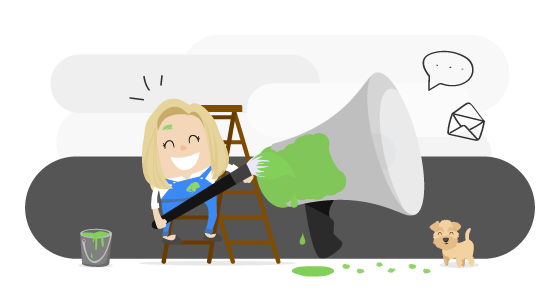The content marketing guide that delivers: create content to attract and retain
Mar 04 2025 / 11 min
What is content marketing and how does it work? Spoiler: you might already be doing it!
If you’re creating, publishing, and sharing posts, news, articles, illustrations, or videos, here’s some news: you’re already familiar with content marketing! Content marketing encompasses any text or visual content on the web that you use to inform or attract a targeted audience (essentially, the clients you aim to reach).
Questions to ask yourself
- Does my content align with my branding?
- Does my content address the interests, industry, and company size of my target audience?
- Is my content directed at the right stakeholders within my clients’ organizations?
- Is my content being shared at the right time and on the right platforms?
- Is my content presented in the appropriate format?
Content marketing vs. inbound marketing
Contrary to popular belief, content marketing is not synonymous with inbound marketing. However, content marketing is one of the many strategies within inbound marketing!
The burning question: why engage in content marketing (AKA is it really worth it)?
As you might have guessed from the title of our guide, content marketing truly helps acquire new clients and retain existing ones (yes, even for B2B companies!). The evidence speaks for itself.
of B2B marketers successfully use content marketing to generate leads1.
of B2B buyers prefer practical content like case studies to inform their purchasing decisions, citing “the need for credible sources”2
Content marketing generates 3 times as many leads as outbound marketing and costs 62% less3.
of buyers consume 3 to 5 pieces of content before engaging with a sales representative4.
3https://www.demandmetric.com/content/content-marketing-infographic
4https://blog.hubspot.com/marketing/content-marketing#Content%20Marketing%20Statistics
Investing in content marketing pays off in customer acquisition
Your clients want to learn more. They’re curious and seek to compare case studies and market offerings before making a purchase. Once you’ve attracted them with engaging, relevant, and useful content, they’re nearly convinced. Bingo! They’ve become your clients, and your future branded content will serve to retain them… while also attracting other potential clients!
No business is too “boring” for content marketing
Even if you sell heat pumps or management software, there’s no need to worry: anything is possible when it comes to web content. As we often say, there’s no such thing as an industry too dull for content marketing! By simplifying technical content or illustrating a process, it’s always possible to stand out and make your efforts profitable.
You’ve decided to embark on B2B content marketing—yeah! But first, you need a strategy… sorry!
Strategy is essential before creating content
We know you’re itching to dive right into Canva! But please, hold back: if you want your content marketing to be profitable, you need a well-thought-out content strategy.
Productivity, coherence, and consistency are the key words here. After all, you certainly don’t want to make mistakes and reduce the return on investment of your efforts by publishing last-minute content that won’t really interest your target clients!
1. Your objectives, or determining how content could be profitable for your business
We created this guide to demonstrate our expertise in content marketing (awareness), position ourselves on search engines (organic SEO), and make B2B companies understand that branded content is profitable for them (client acquisition). And you know what? It worked!
Because we defined our objectives, and we wrote what was needed, for the right people.
2. Your target client, or how to convince the person responsible for choosing you
Let’s say your target clients are real estate development companies. Who contacts you for projects? The construction contractor submitting the bid, or the architect designing the plans? Without a clear persona, you’ll have difficulty knowing what to say and how to say it to make them want to choose you.
The ABCs of creating a persona
Have fun imagining your target client to the point of giving them a face, by browsing royalty-free photos.
Give them a name (Guy Tremblay), responsibilities (sales and business development), and main tasks (finding a supplier). Indicate their content consumption habits (news), irritants (hates wasting time), and what it takes to convince them (demonstration of efficiency, case studies, reduced costs, quick turnaround).
You have a video to edit or a comparison chart to structure? Imagine you’re speaking to Guy!
3. Your content topics: what to say to attract and convince your potential and current clients
The moment you’ve been waiting for: it’s time to connect the dots between your business goals and your target clients by identifying high-conversion content topics.
Think about what might catch the attention of your prospects and existing clients. Should you focus on your success stories, industry trends, or company values? Here are a few ways to help you pinpoint the right content ideas:
- Keep an eye on what thought leaders in your industry are talking about.
- Analyze engagement rates on your existing content.
- Explore blogs and forums in your field to spot hot topics.
- Look at frequently asked questions in search engines for inspiration.
- Golden rule: Don’t try to cover too much at once. One piece of content = one topic!
4. The tone of your content: dressing appropriately for the occasion
The tone of your business communications is akin to attire. At a gala, you’d wear an evening gown; on a patio, a summer dress. Your choice speaks volumes about you and your company, influencing your target clients’ perceptions, much like non-verbal cues in a conversation.
There are several tone types you’re likely familiar with: approachable, friendly, serious. But don’t get bogged down by labels. Instead, select three or four attributes that define your brand.
For instance, you might describe your voice as positive, passionate, expert, and educational. When it’s time to review content, refer back to these attributes to ensure the tone aligns.
- Is your message reader-friendly?
- Is it appropriately formal?
- Does it provide valuable insights?
If the answer is yes, you’re on the right track. The key is for every team member to maintain this consistent tone, ensuring coherent communications.
5. Content volume and frequency, or how to publish strategically
Wondering whether you should publish once, twice, or seven times a week? Start by looking at what your competitors are doing and what your market research reveals. There’s no one-size-fits-all answer when it comes to publishing frequency or volume; what truly matters is quality.
Relevant content will always be appreciated. Empty content, on the other hand, can drive readers (and potential clients) away.
Each phase of your content strategy shouldn’t take more than a week to complete. Make sure all stakeholders are clearly identified, as well as any key dates or events for your business. Most importantly, don’t overlook your tools: a collaborative dashboard is highly recommended!
*Available in French only
Time to write, design, and shoot!
A thousand ways to bring your content to life
When we talk about content creation, writing usually comes to mind first. But content marketing comes in all shapes and formats! To help guide your choices, take a look at what your competitors are doing and, more importantly, how your own clients are reacting to what you’re sharing.
of marketers will start using short-form videos in 2024.
Source: Hubspot
Every content format has its purpose White paper vs. eBook: choose the right format 15 ideas to replace the traditional corporate video
Pro tip
Repurposing your content
Don’t hesitate to get the most out of your efforts: one topic can be leveraged across multiple content formats and types! It’s also an opportunity to capitalize on your team’s strengths.
Let’s say you’re comfortable in front of the camera but don’t enjoy writing. Record a product test video. Then ask a creative colleague to turn the results into an infographic and another who’s good with words to write an article. Just like that, you’ve got three pieces of quality content to share on your channels!
Choosing to write? Watch out for these 3 visual pitfalls
You might be wondering: what does visual layout have to do with writing? Everything! On screen, we tend to read by scanning, not line by line. That means anything that distracts the eye can get in the way of clarity and readability.
To keep your digital content impactful, steer clear of these three common traps:
1. Long paragraphsOn-screen reading makes us lazy. Long blocks of text are a major turnoff. Stick to short paragraphs, ideally no more than five lines, that invite the reader to keep going. |
2. Funky fontsArial and Verdana might not be thrilling, but they’re some of the easiest fonts to read online. Avoid unusual fonts that are hard to read or may not display properly across all platforms. |
3. Overusing boldBold text is great for highlighting key information… until you overdo it! Then it just creates visual noise. Use bold type sparingly to keep your content readable and impactful. |
If your content is lacking visual punch, try replacing some text elements with images or illustrations that incorporate text, like quotes, stats, or section titles.
How to write a strong web article
Step 1: Identify and list the article’s key sections
Step 2: Organize your sections by importance
Step 3: Add subheadings to each section
Step 4: Write short, simple sentences
Step 5: Use visuals to enhance or clarify your message
In-house or outsourced content creation?
Time
Let’s face it: content creation takes time. Strategy, planning, research, production, approvals, and performance tracking can take weeks for a single piece of content. Outsourcing can free up that time and accelerate your output.
of companies say that delivering a high volume of marketing projects with a small team is one of their top three challenges, and 39% rank it number one!
Source: Inside Quebec’s B2B Marketing, Bang Marketing, 2024.
*Available in French only
Quality
Creating content? Easy. Creating quality content that delivers results? Not so much.
Even if your internal team has the time to design visuals or write blog posts, will the outcome truly support your business goals?
To generate calls and sales, your content needs to rank on Google and be crafted strategically to drive conversions.
The SEO essentials behind successful digital content marketing
Use the right keywords in the right places
Your goal is to land your content as high as possible in Google’s search results, but it won’t happen on its own! Select 1 to 3 keyword phrases your ideal clients might type into Google when searching for your content, and weave them naturally into your article.
It’s a simple equation: top Google ranking + high-quality content = ROI
Write titles that punch (for Google 🤖 and your readers 👩💻)
An article title needs to include keywords and grab attention. Sounds impossible? Not with us!
Bang’s go-to tips for great titles
- Numbers work: start with them in your titles.
- Educational formats draw clicks (How-tos, Guides, etc.).
- Including the current year adds a sense of freshness and relevance that readers appreciate.
- Comparisons spark curiosity.
- Avoid clickbait: it turns readers off.
How to write a blog title without the headache?
Ready, set, structure your content!
A web article broken down into short paragraphs, each focusing on a single idea, is much easier to read on-screen. It also gives you a great opportunity to place keywords where they matter most: in your subheadings.
Google reads your article’s headings like a table of contents to determine whether the content is relevant to readers. If it deems your article valuable, it’s more likely to rank it higher in search results.
Behind the scenes, in your website’s CMS, make sure to tag your headings properly and follow the expected hierarchy:
<H1>: Title
<H2>: Subheadings
<H3>: Supporting information
<H4> à <H6>: In-depth content
Prioritize your top keywords in H1 and H2 headings. Google gives them more weight in SEO!
Internal linking: 3 reasons to include links in your web article
1. Help Google understand your site structure |
2. Share page authority across your site |
3. Improve user experience |
There are two types of internal links:
- Structural internal links are built into the site’s architecture to help users navigate (main menu, footer, or sidebar).
- Contextual internal links are embedded within your content and direct readers to other articles or pages on your site, like when we invite you to check out our article on mastering the art of anchor text. 😉
Use both types of links for maximum impact!
FAQs to boost your SEO
Many businesses limit their keyword strategy to service-based queries (e.g., content marketing agency in Montreal), but question-based queries are often untapped goldmines (e.g., Why invest in content marketing?).
FAQs are especially helpful when it’s tough to naturally include questions in your article.
Choose the right questions
Talk to your sales team: What do prospects ask the most? Also, don’t ignore Google’s People Also Ask section: it’s a secret weapon for your SEO!
Share your content with the world
Where to share your content marketing campaigns?
Social mediaSocial media is perfect for quickly engaging your audience and boosting your brand visibility. In B2B, LinkedIn is the go-to platform.
|
NewletterNewsletters are sent directly to your subscribers’ inboxes, helping you stay clear of ever-changing algorithms from tech giants. |
AdvertisingGoogle Ads and LinkedIn Ads are great for quickly promoting content, especially when paired with an SEO strategy that drives long-term results.
|
Your website(visuel: le site web est au centre et les canaux de diffusion pointent vers celui-ci.)
|
||
Listening platformPodcasts are a great way to build brand presence in a more intimate, conversational format. They’re often used to explore topics in greater depth.
|
Educational platformWebinars help educate and engage your audience on specific topics while attracting new, qualified leads.
|
Sales toolsSales tools like presentations and brochures are essential for supporting your sales teams in closing deals.
|
The 5 added values of a content calendar
OverviewYou don’t want to accidentally publish multiple pieces on the same topic or overlook a key content format. A calendar helps you plan ahead for important dates and events.
|
(visuel) |
| (visuel) |
ConsistencyA content calendar keeps you aligned with your original strategy over time, ensuring consistency and regularity in what you publish.
|
ControlA strong content calendar outlines deadlines and responsibilities at every stage. It keeps your process on track and helps you avoid oversights, errors, and duplicates.
|
(visuel) |
| (visuel) |
InspirationOne brainstorm session can fuel your content for the entire year. The content calendar is your best defense against creative block.
|
Performance trackingAdd performance data directly into your calendar to quickly assess and adjust your content based on user reactions.
|
(visuel) |
What to include in a content calendar
- The theme and topic of the content
- The chosen angle or perspective
- Keywords to include
- Links to insert in the online version
- Content format
- People responsible for each step of the creation process
- Deadlines for each step
- Current status (in progress, under review, approved)
- Selected distribution platforms
- Target publishing dates
Is your content marketing paying off?
Performance indicators that speak for themselves
Remember those objectives you defined during the strategy phase? Now’s the time to check whether your content helped you reach them.
- Did you attract new clients (inbound calls or emails from leads)?
- Did existing clients purchase more (increased revenue)?
- Did you grow brand awareness in a new region (website traffic from that area)?
- Did you boost sales for a featured product or service promoted through your content (content ranking well on Google)?
If the results aren’t there yet, don’t worry: one of the biggest advantages of online content is that it’s flexible and can be improved at any time.
Content marketing is a continuous effort
Unlike print materials, which can’t be changed once they’re out in the world, online content can (and should) be optimized over time to maximize its impact. Don’t hesitate to refresh your visuals, infographics, or articles based on user engagement, emerging trends, or new business goals.
*ROI and content marketing: is your strategy paying off?
*Available in French only
The best content marketing tools for…
Finding content topics
Free and paid versions.
Enter a keyword, and the tool generates a report listing frequently asked questions from various sources on the web.
Paid version only.
Similar to the previous tool, enter a keyword to generate a report listing frequently asked questions. However, this tool exclusively displays questions from Google. Get an overview of the questions without the tool by browsing Google’s “People also ask” section yourself after entering a keyword in the search bar.
Researching and analyzing keywords
Free version (available to Google Ads account holders) and paid version.
Paid version only.
Both tools provide keyword suggestions ranked by monthly search volume and competition level on the web.
Structuring web articles
Paid version only.
Paid version only.
These two well-developed tools help optimize blog articles for better performance on Google. They provide recommendations on word count, number of <h2> and <h3> tags, contextual keywords to include, and more.
Doing it all!
Paid version only.
If you have the budget, this tool is a top choice for your content marketing. It does everything we’ve mentioned, and more!
What about AI?
With tools like ChatGPT, Jasper, and Copy.ai, it might feel like you’ve struck gold: “I’ve got my content!”
AI can certainly give you a boost, whether for brainstorming topics or drafting content. But remember, your competitors have access to the same tools. To truly stand out, you need to refine and personalize the AI-generated content to make it 100% original!
A profitable piece of content is one that keeps improving
6 ways to enhance your existing content
Add new contentHas something changed in your industry that you should absolutely address to showcase your expertise? Go back to older articles and update them with new insights, trends, or business priorities. |
Add questionsConsider including a FAQ section in your existing articles to boost their SEO value. Add frequently asked questions from your clients, as well as unique queries uncovered during keyword research. |
Refresh keywordsThe best keywords for your older articles may have changed. Periodically revisit your keyword research and update your metadata, titles, and content accordingly. |
Add internal linksIf your articles lack internal linking, now’s the time to fix that. Create an internal link structure that allows readers to navigate your site based on their interests. |
Optimize your imagesImages matter for both user experience and SEO. Review your article visuals, swap out outdated ones, and add relevant keywords in image file names and alt text. |
Improve technical performanceA fast-loading web page is favored by Google and ranks better in search results. Make sure your website’s code is clean and your technology is up to date. |

B2B Brands: Why Dare to Use Emotion and Creativity
We all know the contrast: a B2C ad that moves us to tears or makes us laugh out loud… and a B2B ad we skim through,[...]
Branding
Oct 2, 2025
/11 min

Brand Gravity: How to Attract B2B Clients Without Chasing Them
In a B2B world flooded with information, buyers move far along their journey before ever speaking to a sales repres[...]
Strategy
Sep 22, 2025
/11 min

Bill C-59 and B2B Marketing: What to Expect
Trust has become one of the most valuable currencies in B2B marketing. It influences buying decisions, customer loy[...]
Branding
Sep 8, 2025
/11 min
